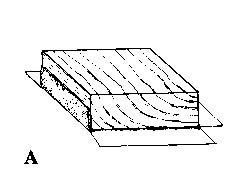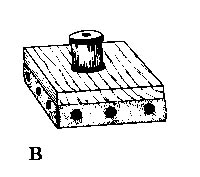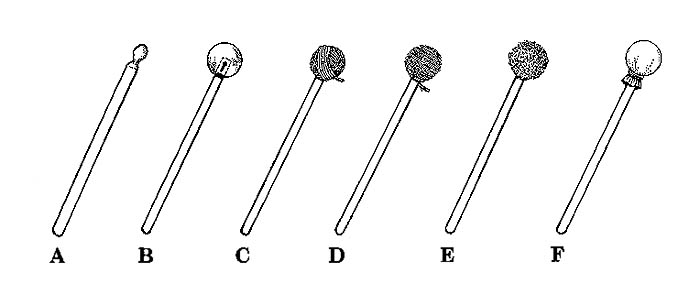|
|
||
| Sandpaper Blocks |
|
| This is another type of scraper that is used in children's rhythm bands. |
|
| Materials: | |
| Two small blocks of pine or plywood, approximately 1" x 4" x 5" (although size
is really not important Sandpaper (experiment with different grades of sandpaper to make different effects). Thumbtacks Thread spools and glue or cabinet knobs and screws |
|
| Assembly: | |
| 1. Cover one side of each block with sandpaper. 2. Fold the sandpaper over the edges and fasten it with thumbtacks. Cut the corners out so sandpaper will fold neatly around the block (A).  3. Trim off excess. 4. Glue or screw handles to the other side of each block (B).  |
|
| Playing Suggestions: | |
| Rub the blocks together in a continuous motion for a swishing, whispering sound or bring the blocks together in a more percussive manner for a more rhythmic effect. | |
| Flower Pot Bells |
|
| Materials: | |
| Clean, unglazed, earthenware flowerpots Heavy cord or twine Mallet or striker Pole or broomstick |
|
| Assembly: | |
| 1. If you want a set of bells to play a scale or tonal pattern, you will have to hand-pick
several sizes of pots and compare their relative pitches. Flowerpots of the same size can
differ by one or two scale degrees. Size and thickness determine the pitch. 2. Suspend the pots upside down from a cord attached to a broomstick or other framework. Don't strike them too hard. |
|
| Options: | |
| You may either tie a large knot in the cord and insert through the hole in each pot before tying to the pole (A), or if the cord is too thin for a good-sized knot, tie it to a small (2") section of dowel before threading though the pot hole (B). | |
 |
 |
| Two-sided Square Drum |
|
| Materials: | |
| Wooden packing crate approximately 12" x 15" x 2" or saw your
owns sides (white cedar was used by Indians). 1-1/2" finishing nails and hammer Long tacks such as furniture tacks with decorative heads rawhide glue scissors |
|
| Procedure: | |
| 1. Saw two 12" lengths and two 15" lengths of wood that are about 1/2" to 1" thick. Make the frame smaller if your piece of rawhide is not large enough to accommodate the suggested size. | |
| 2. Glue and nail drum frame together (A). Let dry. |  |
| 3. Soak rawhide in cool water overnight or in lukewarm water for an hour or two. | |
| 4. Trim rawhide to shape so that both sides will be covered with enough to wrap around and tack. | |
| 5. Tack rawhide to one side of frame, then pull skin around the box so that skin overlaps the sides and is reasonably taut, not tight. Place a tack about every inch (B). |  |
| 6. Repeat on the other side. Tack skin along edges. Cut out corners so skin will lay flat (C). |  |
| 7. Let dry slowly overnight. | |
| 8. Decorate. | |
| Drumsticks and Mallets |
|
| These sticks and mallets may be used on many percussion instruments. It is important that
the mallet be matched to the instrument so that it will feel "right" in the hand and give
the desired sound. |
|
| Materials: | |
| Sticks 1/4" to 1/2" doweling from 8" to 12" long Chopsticks Tree stems |
|
| Procedure: | |
Hard Ends Take about a foot of 1/2" doweling and carve a broad groove about 5/8" from the end. Sand the ends round, wax (A). Wooden beads drilled out to fit a 1/4" dowel or stick and glued together make good hard mallets (B). Cork that is carved in a round shape or old cork fishing floats fitted to a dowel or stick are also fine beaters. Plastic balls or spools may be glued to a stick. Soft Ends On about one foot of doweling wrap and wind yarn or jute twine as tight as possible until it reaches a diameter of approximately 1". Dab the yarn end completely with white glue. Hold for a few minutes and let dry thoroughly before using (C) (D). Wind a strip of felt around the end of a dowel dabbing a bit of white glue as you wrap. Small rubber balls or erasers carved a round shape and drilled out to fit on the end of a thin dowel make good beaters. Cork, plastic, or wooden balls glued on a dowel and covered with felt, fur, leather, yarn, or other cloth material (such as wool) are excellent (E). The covering may be either glued into the core or wrapped around tightly and tied just under the knob with string or lacing (F). |
|
 |
|